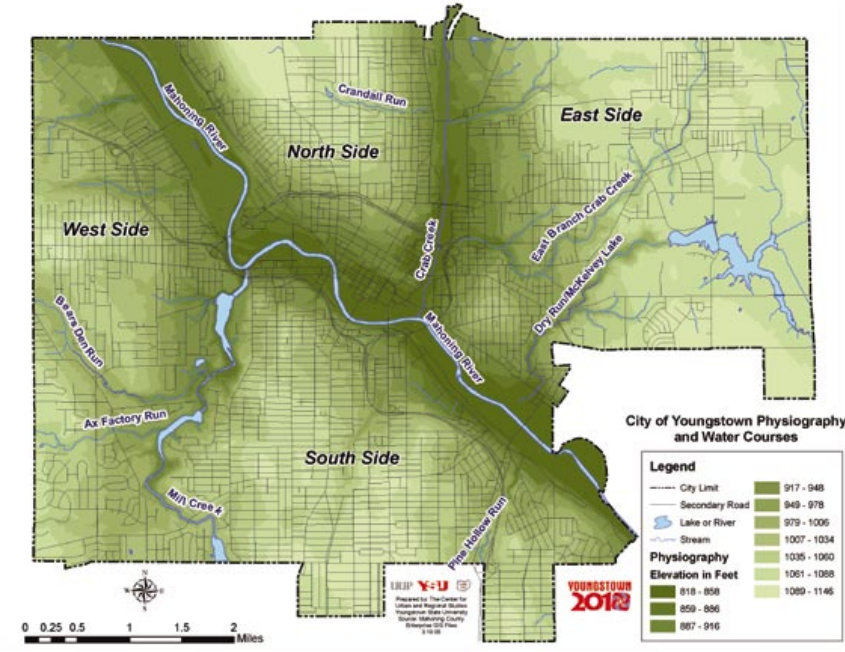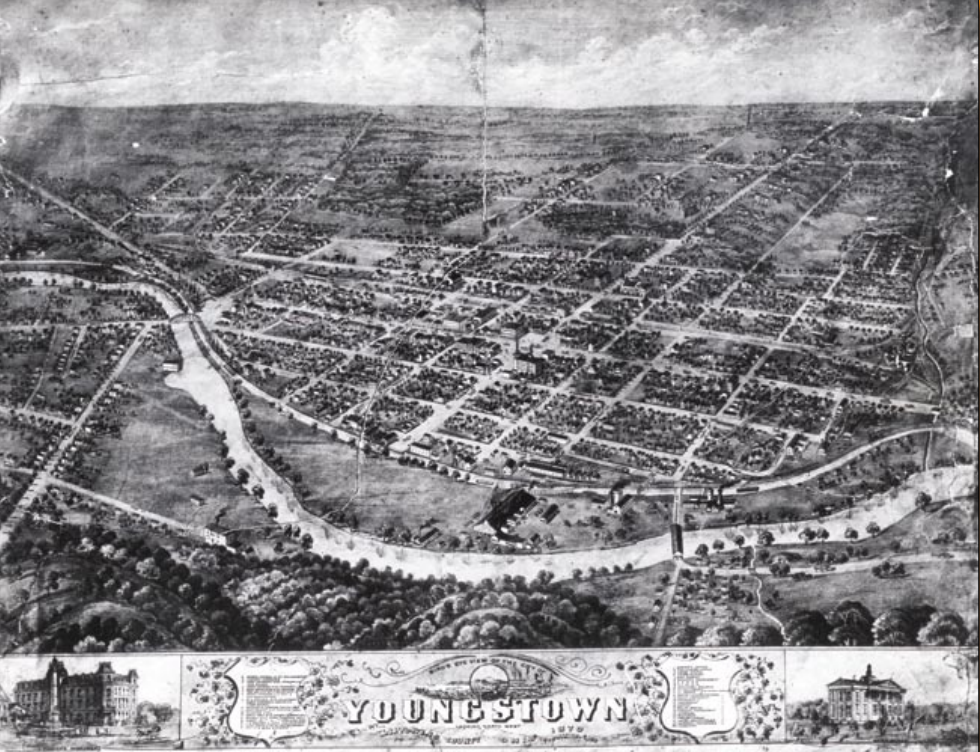Youngstown 2010 Plan
Chapter 1: City History
Development History - Site and Situation
Youngstown, Ohio developed out of the setting, where people were drawn to work in the mines, mills and factories. Youngstown was created by the same factors that led to the establishment of the U. S. industrial belt that stretched from Massachusetts to the Mississippi River: resources, ingenuity and capital. In the chaos of American industrialization and the flow of immigrants, what settled out on John Young’s township was this unique city.
Physical Setting

Youngstown lies on the glaciated portion of the Allegheny Plateau. As the last glaciers retreated 12,000 years ago they left behind a landscape dramatically different from the heavily eroded table lands that existed prior to their advance. Glacial till filled the steep valleys leaving behind a relatively uniform plain. The melting ice carved out the Mahoning River, which drains into the Ohio River Basin.
During the 120 centuries that have passed since the retreat of the last ice sheets, the land that now is the setting of Youngstown underwent a further sculpting by rain and runoff creating Mill Creek and Crab Creek, the tributaries that define eastern and western extent of the wide Mahoning River floodplain that John Young platted as “Young’s Town” (see Map 1). The Mahoning River, Mill Creek and Crab Creek basins formed the boundaries of what would become culturally engrained as the four ‘sides’ of Youngstown. Over time the valleys became the site of Youngstown’s industry and the high ground provided living space for its people.
Youngstown grew in spurts from its corporate infancy in 1869 to its great spatial expansion in 1929 (see Map 2). The City expanded with its industry and population until the township was entirely absorbed and portions stretched into Boardman, Liberty and Coitsville Townships. Following 1929, territorial growth was minimal as suburbs resisted annexation.

Youngstown as part of the great American manufacturing belt was pulled and influenced by forces from its larger neighbors, Cleveland and Pittsburgh. It took on traits of the river valley mill town that was Pittsburgh and the industrialized Great Lakes gateway that was Cleveland. The result was uniquely Youngstown, a place linked to two distinct regions but acknowledged by neither. This paradox of connection and isolation would shape the mindset that led Youngstown to its industrial dominance and exacerbated its fall as deindustrialization swept across America’s heartland.
Why We Need a Plan
When steel’s reign came to a screeching halt and the smoke literally cleared, Youngstown was left with no vision and no plan to deal with the aftermath, not that any city so hard hit by similar economic forces did. Youngstown was operating on a comprehensive plan adopted in 1951 and updated in 1974 that was based on growth and expansion. By the late 1970s the plan was without foundation and virtually obsolete. Youngstown lacked direction through its decline, and without vision languished for the next twenty-five years.
The collapse of the steel industry and the impact it had economically and socially has made it extremely difficult to begin a process of revitalization. Few, if any, cities have experienced the highs of being the third largest steel producing city in the U.S. at one time with census data showing its highest per capita family income locally (adjusted for inflation) in 1960 to losing 40,000 manufacturing jobs overnight and garnering national attention for crime and corruption. Youngstown’s and the entire region’s future is dependent on a positive, planned and mutually inclusive journey towards renewal. The civic psyche, inside the City and out, came to this consciousness in 2002 when the spirit of Youngstown 2010 was born. Youngstown 2010 is a planning process to pick up the pieces and organize them to set the stage for sustainable regeneration in the new economy of the 21st century.
Youngstown 2010 is a planning process to pick up the pieces and organize them to set the stage for sustainable regeneration in the new economy of the 21st century.
This resource is an abridged version of the Youngstown 2010 plan. You can access the full version in pdf format below.